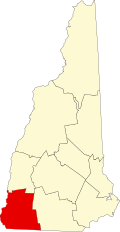Description and history
The Clymer House is located in a rural setting north of the village center of Harrisville, on the north side of Clymer Road, a short stub road extending east from Tolman Pond Road. It is a 1+1⁄2-story wood-frame structure, with a gabled roof, central chimney, and clapboarded exterior. It is set on the stone foundation of an older house. The main facade is three bays wide, and faces west, toward a central barnyard surrounded by a cluster of outbuildings. It has sash windows on either side of a center entrance, which is flanked by sidelight windows. The door and windows both butt against the roof eave, a clear echo of how these types of houses were built in the 18th century. The interior is little altered since its construction, and includes a fireplace with paneled surround. [2]
The house was built in 1932, and is a rare local example of a well-preserved Colonial Revival cottage. The accompanying barn is also from that period, and is like the house built on an old foundation. Other period elements of the property include a garage with batten siding and a small guesthouse. The entire complex has the feel of a traditional 18th-century hill farm, original examples of which are still found in the town. [2]
This page is based on this
Wikipedia article Text is available under the
CC BY-SA 4.0 license; additional terms may apply.
Images, videos and audio are available under their respective licenses.



